The Iceberg Thermal IceSLEET G6 Stealth Review: Top-Tier Colossal Tower Cooler
by E. Fylladitakis on October 13, 2022 8:00 AM ESTTesting Results, Maximum Fan Speed
To begin with, we are having a look at the IceSLEET G6 Stealth with its stock 140 mm fan running at its maximum speed.

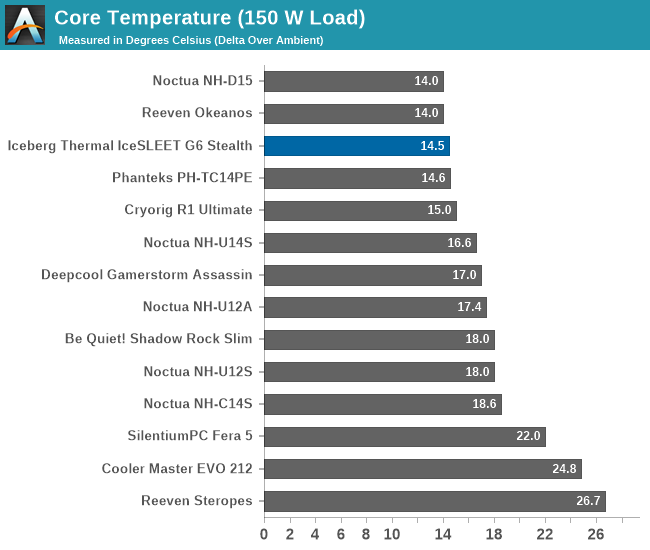
| Core Temperature, Constant Thermal Load (Max Fan Speed) |
Due to its enormous mass, we expected the IceSLEET G6 Stealth to land near other similarly-sized products, such as the Noctua NH-D15 and the Phanteks PH-TC14PE. We were not mistaken, as the average thermal resistance of 0.099 °C/W is extremely close to the figures we received from those other coolers.
The IceSLEET G6 Stealth seems to have trouble coping with very low loads, as the thermal resistance is unnaturally high in those scenarios, hinting that the energy transfer is rather slow. As the load increases and the temperature gap between the cooler and the cooling medium (air) widens, the thermal resistance drops considerably.
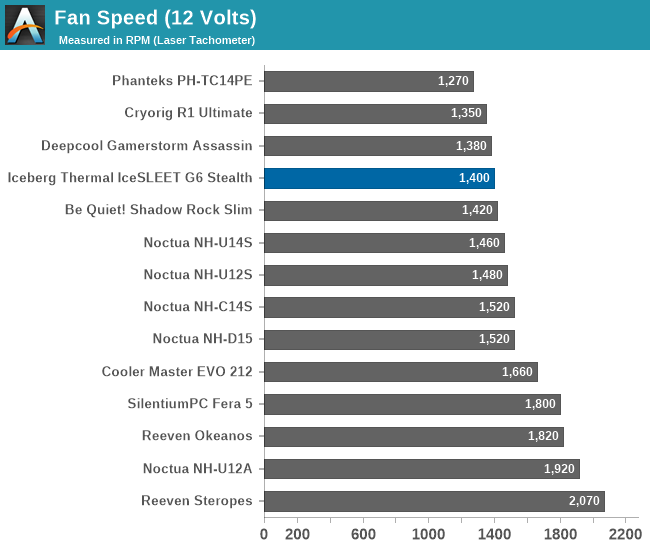
The IceSLEET G6 Stealth is, as its name also suggests, a product designed with acoustics in mind. Its 140 mm fan spins at exactly 1400 RPM and makes a rather good job of keeping noise levels relatively low. The cooler is clearly audible with the fan running at maximum speed but even then the noise pressure figures are tolerable for typical stress usage scenarios.
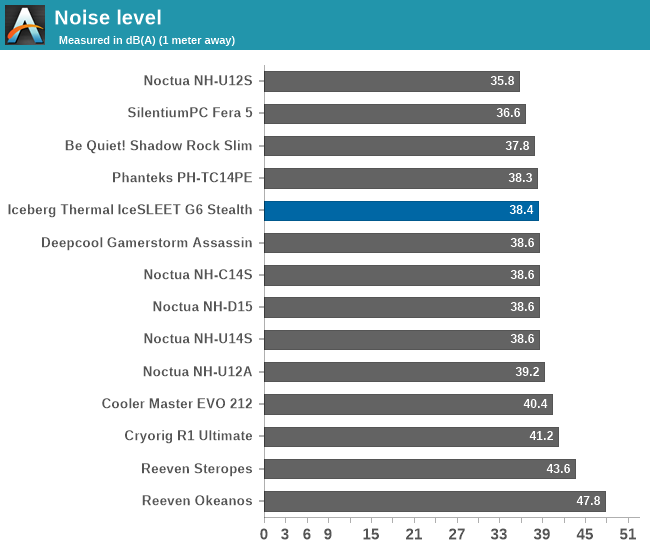
Testing Results, Low Fan Speed
Switching things up a bit, let's next take a look at cooler performance with the Iceberg Thermal 140 mm fan taken down to half speed.
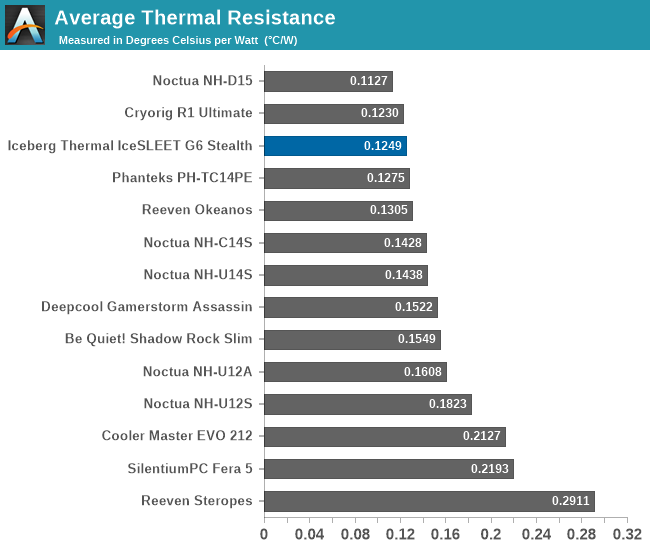
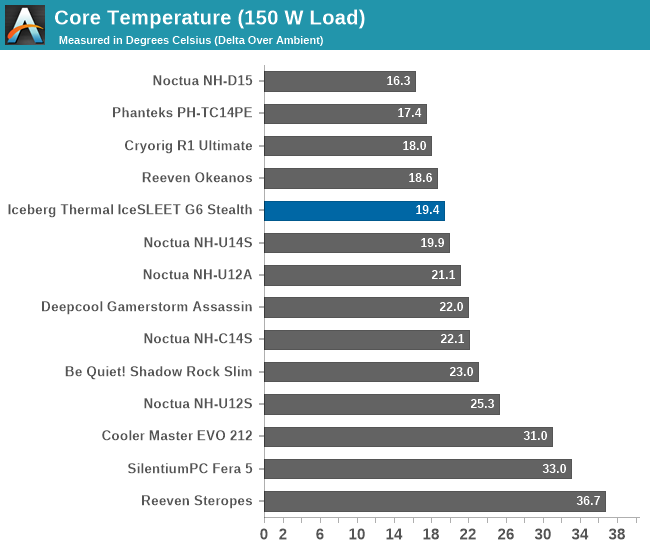
| Core Temperature, Constant Thermal Load (Low Fan Speed) |
After reducing the speed of the fan to about 700 RPM, the thermal performance of the IceSLEET G6 Stealth degraded only slightly, as expected from a cooler with so much mass and surface area. Once again, the thermal performance of the IceSLEET G6 Stealth is on par with that of other similarly sized coolers. It also follows the same pattern, with mediocre thermal resistance at very low loads and exceptional figures when the load is very high.

Dropping the speed of the Iceberg Thermal 140 mm fan down to 720 RPM makes the IceSLEET G6 Stealth cooler practically inaudible. With no direct line of sight, it is impossible to discern whether the fan is spinning or not even if very close to the cooler. It would take a very quiet room and very close proximity to hear the fan under such conditions.
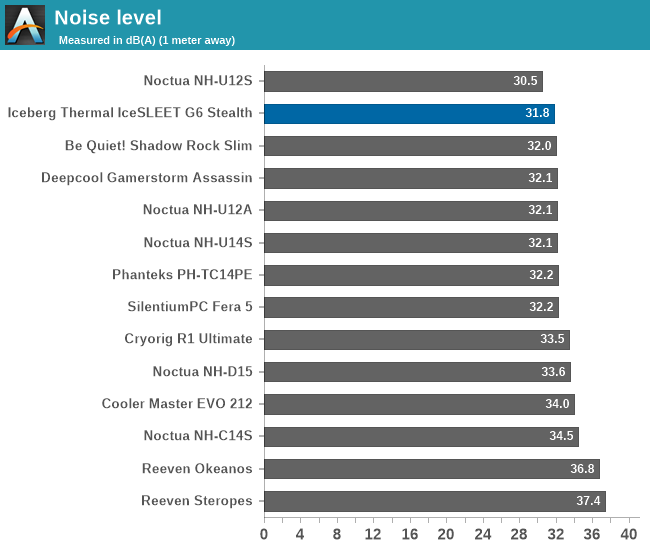
Thermal Resistance VS Sound Pressure Level
During our thermal resistance vs. sound pressure level test, we maintain a steady 100W thermal load and assess the overall performance of the coolers by taking multiple temperature and sound pressure level readings within the operating range of the stock cooling fans. The result is a graph that depicts the absolute thermal resistance of the cooler in comparison to the noise generated. For both the sound pressure level and absolute thermal resistance readings, lower figures are better.
This chart reveals where the IceSLEET G6 Stealth lands at compared to its major competitors. We can see that practically only the Noctua NH-D15 slightly outperforms the Iceberg Thermal cooler, with every other cooler matching the same thermal performance at higher sound pressure levels.


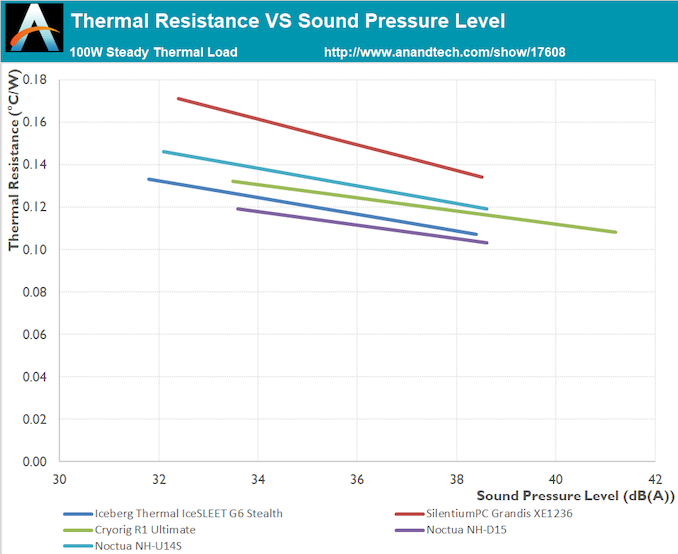








22 Comments
View All Comments
Avalon - Thursday, October 13, 2022 - link
Seems like a good cooler and quite similar to the Be Quiet! Dark Rock Pro 4. Any chance you'll be reviewing the latter?ballsystemlord - Thursday, October 13, 2022 - link
That tower cooler is amazing at higher heat outputs. Perfect for the new AMD/Intel CPUs.rickeo - Sunday, October 16, 2022 - link
That direct heatpipe contact will likely NOT be good for modern AMD chiplet CPU's.Threska - Thursday, October 13, 2022 - link
Should have covered ease of installation. Some can be difficult especially dealing with weight and size in an already installed motherboard.meacupla - Thursday, October 13, 2022 - link
I'm surprised direct touch heatpipes are still a thing. I would have expected the manufacturers to have added a vapor chamber by now. The heat output on these newer chips aren't evenly spread out, unlike when the NH-D15 was released.DanNeely - Thursday, October 13, 2022 - link
As long as reviewers are sufficiently scared of random temporal variations that they use isothermal resistive heating elements lazy manufactures don't need to bother with actual CPU thermal distributions in the pursuit of fake internet points in review scores.Meanwhile manufacuers that do try to take such factors into consideration (a decade ago there was a CPU waterblock manufacturer that offered different flow guides for different CPU families for an extra 1-2C cooling vs a generic setup) at best get no benefit for their work and at worst actually score worse because they're not as efficient at cooling a space heater where actual CPUs don't put much of their heat.
thestryker - Thursday, October 13, 2022 - link
While I agree with you in principal you're also asking reviewers to do a *lot* more work and have results which can't be directly compared. Intel's CPUs, at least until MTL, the heat is right in the center whereas AMD has been off to the side which means you'd have to test both if you want useful results. On top of that you'd also have to test with an offset (or whatever other method is being used) and without to see if there is an actual benefit (Der8auer tested AMD offset on Zen 4 and found no difference).In the end so long as reviewers address the availability of any extra features which may assist specific platform cooling that's good enough for me.
404NotFound22 - Friday, October 14, 2022 - link
Actually no, while Der8auer himself didn't find a difference, his comment section sure did. The benchmark score went up, while the temperature remained the same, as is expected from Zen 4. He admitted not seeing this and said a revised video is coming.So yes it did make a difference.
thestryker - Friday, October 14, 2022 - link
He's running a manual OC on the chip, so no that behavior is not expected at all. We won't know what's going on until he's able to rerun the testing.(I'd missed the benchmark performance entirely though since I was only listening to the video)
Stuka87 - Thursday, October 13, 2022 - link
There have been vapor chamber coolers in the past, such as the CoolerMaster TPC 812. With the way current CPUs have very uneven hot spots, vapor chambers do start to make more sense.The IceGiant ProSiphon is the closest thing we have these days, and it does work really well, though its on the large side.